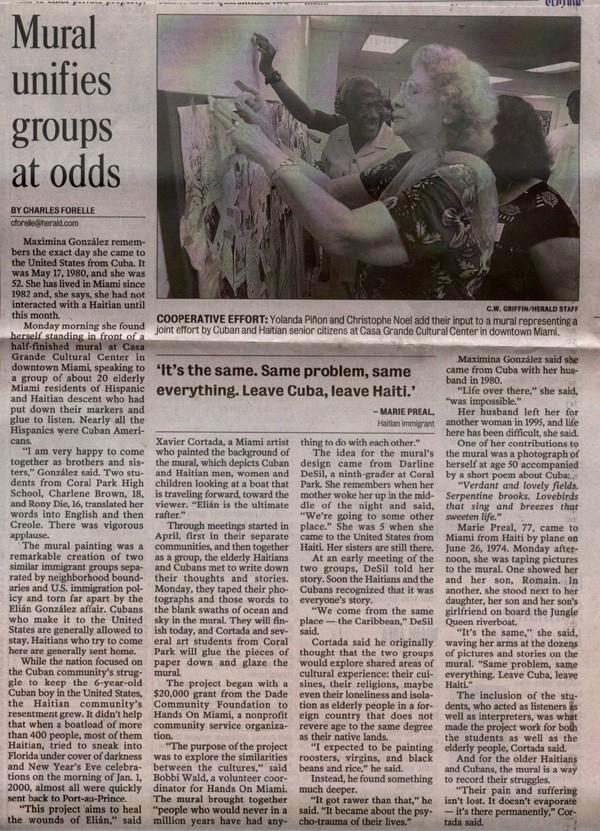The Miami Herald
May 22, 2001
By Charles Forelle
Maximina González remembers the exact day she came to the United States from Cuba. It was May 17, 1980, and she was 52. She has lived in Miami since 1982 and, she says, she had not interacted with a Haitian until this month.
Monday morning she found herself standing in front of a half-finished mural at Casa Grande Cultural Center in downtown Miami, speaking to a group of about 20 elderly Miami residents of Hispanic and Haitian descent who had put down their markers and glue to listen. Nearly all the Hispanics were Cuban Americans.
“I am very happy to come together as brothers and sisters,” González said. Two students from Coral Park High School, Charlene Brown, 18, and Rony Die, 16, translated her words into English and then Creole. There was vigorous applause.
The mural painting was a remarkable creation of two similar immigrant groups separated by neighborhood boundaries and U.S. immigration policy and torn far apart by the Elián González affair. Cubans who make it to the United States are generally allowed to stay. Haitians who try to come here are generally sent home.
While the nation focused on the Cuban community’s struggle to keep the 6-year-old Cuban boy in the United States, the Haitian community’s resentment grew. It didn’t help that when a boatload of more than 400 people, most of them Haitian, tried to sneak into Florida under cover of darkness and New Year’s Eve celebrations on the morning of Jan. 1, 2000, almost all were quickly sent back to Port-au-Prince.
“This project aims to heal the wounds of Elián,” said Xavier Cortada, a Miami artist who painted the background of the mural, which depicts Cuban and Haitian men, women and children looking at a boat that is traveling forward, toward the viewer. “Elián is the ultimate rafter.”
Through meetings started in April, first in their separate communities, and then together as a group, the elderly Haitians and Cubans met to write down their thoughts and stories. Monday, they taped their photographs and those words to the blank swaths of ocean and sky in the mural. They will finish today, and Cortada and several art students from Coral Park will glue the pieces of paper down and glaze the mural.
The project began with a $20,000 grant from the Dade Community Foundation to Hands On Miami, a nonprofit community service organization.
“The purpose of the project was to explore the similarities between the cultures,” said Bobbi Wald, a volunteer coordinator for Hands On Miami. The mural brought together “people who would never in a million years have had anything to do with each other.”
The idea for the mural’s design came from Darline DeSil, a ninth-grader at Coral Park. She remembers when her mother woke her up in the middle of the night and said, “We’re going to some other place.” She was 5 when she came to the United States from Haiti. Her sisters are still there.
At an early meeting of the two groups, DeSil told her story. Soon the Haitians and the Cubans recognized that it was everyone’s story.
“We come from the same place – the Caribbean,” DeSil said.
Cortada said he originally thought that the two groups would explore shared areas of cultural experience: their cuisines, their religions, maybe even their loneliness and isolation as elderly people in a foreign country that does not revere age to the same degree as their native lands.
“I expected to be painting roosters, virgins, and black beans and rice,” he said.
Instead, he found something much deeper.
“It got rawer than that,” he said. “It became about the psycho-trauma of their lives.”
Maximina González said she came from Cuba with her husband in 1980.
“Life over there,” she said, “was impossible.”
Her husband left her for another woman in 1995, and life here has been difficult, she said.
One of her contributions to the mural was a photograph of herself at age 50 accompanied by a short poem about Cuba:
“Verdant and lovely fields. Serpentine brooks. Lovebirds that sing and breezes that sweeten life.”
Marie Preal, 77, came to Miami from Haiti by plane on June 26, 1974. Monday afternoon, she was taping pictures to the mural. One showed her and her son, Romain. In another, she stood next to her daughter, her son and her son’s girlfriend on board the Jungle Queen riverboat.
“It’s the same,” she said, waving her arms at the dozens of pictures and stories on the mural. “Same problem, same everything. Leave Cuba, leave Haiti.”
The inclusion of the students, who acted as listeners as well as interpreters, was what made the project work for both the students as well as the elderly people, Cortada said.
And for the older Haitians and Cubans, the mural is a way to record their struggles.
“Their pain and suffering isn’t lost. It doesn’t evaporate – it’s there permanently,” Cortada said.
